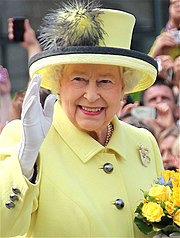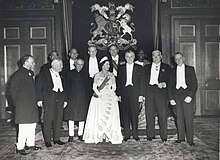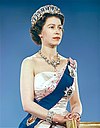Head of the Commonwealth
| Head of the Commonwealth | |
|---|---|
 Personal flag of Queen Elizabeth II | |
 Elizabeth II since 6 February 1952 | |
| Seat | Marlborough House, London |
| Appointer | Commonwealth heads of government |
| Term length | Life |
| Inaugural holder | George VI |
| Formation | 28 April 1949 |
| Website | thecommonwealth.org |
Head of the Commonwealth is a title used by the ceremonial leader who symbolises "the free association of independent member nations" of the Commonwealth of Nations, an intergovernmental organisation that currently comprises fifty-four sovereign states. There is no set term of office or term limit and the role itself involves no part in the day-to-day governance of any of the member states within the Commonwealth. The title has been held by the reigning British monarch since its establishment.
By 1949, the British Commonwealth was a group of eight countries, each having King George VI as monarch. India, however, desired to become a republic, but not to leave the Commonwealth by doing so. This was accommodated by the creation of the title Head of the Commonwealth for the King, and India became a republic in 1950. Subsequently, many other nations including Pakistan, Sri Lanka, Ghana and Singapore ceased to recognise the monarch of the United Kingdom as their respective head of state, but recognised the British monarch as Head of the Commonwealth as members of the Commonwealth of Nations.[1]
The title is currently held by Queen Elizabeth II, George VI's elder daughter. Charles, Prince of Wales, was appointed her designated successor at the Commonwealth Heads of Government Meeting 2018.
Title[]
The title was devised in the London Declaration as a result of discussions at the 1949 Commonwealth Prime Ministers' Conference. It is rendered in Latin as Consortionis Populorum Princeps,[2][3][4] and in French as Chef du Commonwealth.[5]
Position[]

The Head of the Commonwealth, currently Queen Elizabeth II, is recognised by the members of the Commonwealth of Nations as the "symbol of their free association" and serves as a leader, alongside the Commonwealth Secretary-General and Commonwealth Chair-in-Office. Although Queen Elizabeth II is head of state in 15 members of the Commonwealth, she does not have any role in the governance of any Commonwealth state as Head of the Commonwealth itself.
The head of the Commonwealth or a representative (such as Charles, Prince of Wales) attends the biennial Commonwealth Heads of Government Meeting (CHOGM), held at locations throughout the Commonwealth. This is a tradition begun by the monarch on the advice of Canadian Prime Minister Pierre Trudeau in 1973,[6] when the CHOGM was first held in Canada. During the summit, the head of the Commonwealth has a series of private meetings with Commonwealth countries' leaders, attends a CHOGM reception and dinner, and makes a general speech. The Queen or a representative is also present at the quadrennial Commonwealth Games and on every Commonwealth Day, the second Monday in March, broadcasts a message to all member countries.
History[]

In 1949, King George VI was king of each of the countries that then comprised the British Commonwealth (later the Commonwealth of Nations): the United Kingdom, Canada, Australia, New Zealand, South Africa, India, Pakistan, and Ceylon. However, the Indian Cabinet desired the country to become a republic, but not to leave the Commonwealth as a consequence of no longer having George VI as king, as happened to Ireland. To accommodate this, the London Declaration issued in late April 1949,[7][8][9][10] and devised by Canadian prime minister Louis St. Laurent, stated that the King, as the symbol of the free association of the countries of the Commonwealth, was the head of the Commonwealth. When India adopted a republican constitution on 26 January 1950, George VI ceased to be its monarch (the president of India, Rajendra Prasad, became head of state), but it did regard him as Head of the Commonwealth.
Elizabeth II became Head of the Commonwealth on her accession in 1952, stating at the time, "The Commonwealth bears no resemblance to the empires of the past. It is an entirely new conception built on the highest qualities of the spirit of man: friendship, loyalty, and the desire for freedom and peace."[11] The following year, a Royal Style and Titles Act was passed in each of the Commonwealth realms, adding for the first time the term Head of the Commonwealth to the monarch's titles.
In December 1960, the Queen had a personal flag created to symbolise her as Head of the Commonwealth and not associated with her role as queen of any particular country. Over time, the flag has replaced the British Royal Standard when the Queen visits Commonwealth countries of which she is not head of state (and thus does not possess a unique royal standard for that state) and on Commonwealth occasions in the United Kingdom. When the Queen visits the headquarters of the Commonwealth Secretariat in London, this personal standard—not any of her royal standards—is raised.[12]
Former Canadian Prime Minister Brian Mulroney said Elizabeth was a "behind the scenes force" in ending apartheid in South Africa.[13][14][non sequitur]
Succession[]

By 2018, with the Queen in her 90s, and the position of "Head of the Commonwealth" not technically hereditary, talks as to whether or not Prince Charles or someone else should become the third person to hold it had been going on for some time.[15] The London Declaration states that "The King [acts] as the symbol of the free association of its independent member nations and as such the Head of the Commonwealth", whereby both republics and kingdoms that are not Commonwealth realms can recognise the monarch as Head of the Commonwealth without accepting the person as the country's head of state. However, though each Commonwealth realm's laws on royal titles and styles make Head of the Commonwealth part of the reigning monarch's full title, and Queen Elizabeth II declared in 1958, through the Letters Patent creating her son, Prince Charles, as Prince of Wales, that Charles and his heirs and successors shall be future heads of the Commonwealth,[16] there have been conflicting statements on how successors to the position of Head of the Commonwealth are chosen. The Commonwealth Secretariat asserts any successor will be chosen collectively by the Commonwealth heads of government.[17] Commonwealth heads of government, such as the then Canadian Prime Minister Stephen Harper, had already referred to Prince Charles as "the future head of the Commonwealth",[18] and in 2015 the then Prime Minister of New Zealand John Key said, "The title [of Head of the Commonwealth] should just go with the Crown".[19]
Commentators in British newspapers discussed whether it should be a one-off decision to elect Prince Charles to the headship, whether the British monarch should automatically become head of the Commonwealth, or whether the post should be elected or chosen by consensus.[20][21][22] There was also speculation that a rotating ceremonial "republican" headship might be instituted.[23][24] The Daily Telegraph reported that "the post is not hereditary and many leaders want an elected head to make the organisation more democratic."[25]
In 2018, following the 2018 Commonwealth Heads of Government Meeting, Commonwealth leaders declared that Charles would be the next head of the Commonwealth.[26] The role remains non-hereditary.[27][28]
List of heads[]
| No. | Portrait | Name | Birth | Term | Death | |
|---|---|---|---|---|---|---|
| Start | End | |||||
| 1 | 
|
George VI | 14 December 1895 | 26/28 April 1949[n 1] | 6 February 1952 | 6 February 1952 |
| 2 | 
|
Elizabeth II | 21 April 1926 | 6 February 1952 | Incumbent | Living |
See also[]
- Timeline of the Commonwealth of Nations
- List of titles and honours of King George VI
- List of titles and honours of Queen Elizabeth II
- Style of the British sovereign
- Title and style of the Canadian monarch
Notes[]
- ^ Based on the London Declaration.[7]
Footnotes[]
- ^ "About the commonwealth". www.gov.uk. The Foreign and Commonwealth office, UK. Retrieved 12 January 2018.
- ^ "Biography of Elizabeth II (UK)". archontology.org.
- ^ "Burke's Peerage".
- ^ "No. 39873". The London Gazette (Supplement). 26 May 1953. pp. 3023–3023.
- ^ "Lois codifiées Règlements codifiés". Site Web de la législation (Justice). 1 January 2003. Retrieved 31 May 2021.
- ^ Heinricks, Geoff (2001), "Trudeau and the monarchy; National Post", Canadian Monarchist News, vol. Winter/Spring 2000–2001, Toronto: Monarchist League of Canada, retrieved 26 February 2010
- ^ a b London Declaration 1949 (PDF), Commonwealth Secretariat, archived from the original (PDF) on 27 September 2012, retrieved 2 April 2013
- ^ S. A. de Smith (1949), The London Declaration of the Commonwealth Prime Ministers, April 28, 1949, Wiley on behalf of the Modern Law Review
- ^ Queen Elizabeth II and the Royal Family: A Glorious Illustrated History, Dorling Kindersley Limited, 2016, p. 118, ISBN 9780241296653
- ^ "MEETING of PRIME MINISTERS, APRIL, 1949 Text of Final Communique Issued at the Conclusion of the Meeting of Prime Ministers Held at London from 22 to 27 April, 1949, Together with Press Statement by the Right Hon. P. Fraser London, 28 April, 1949". Papers Past. Retrieved 6 September 2021.
- ^ "Head of the Commonwealth". Commonwealth Secretariat. Archived from the original on 31 March 2012. Retrieved 23 March 2009.
- ^ "Mailbox". Royal Insight. September 2006. p. 3. Archived from the original on 19 November 2008.
- ^ Geddes, John (2012). "The day she descended into the fray". Maclean's (Special Commemorative Edition: The Diamond Jubilee: Celebrating 60 Remarkable years ed.): 72.
- ^ MacQueen, Ken; Treble, Patricia (2012). "The Jewel in the Crown". Maclean's (Special Commemorative Edition: The Diamond Jubilee: Celebrating 60 Remarkable years ed.): 43–44.
- ^ Landale, James (13 February 2018). "Commonwealth in secret succession plans". BBC News.
- ^ Elizabeth II, Letters Patent creating Prince Charles Prince of Wales and Earl of Chester, 1958 (PDF), Queen's Printer, retrieved 3 June 2014
- ^ FAQs, The Commonwealth, retrieved 18 December 2013
- ^ Statement by the Prime Minister of Canada on Commonwealth Day, Prime Minister of Canada, 10 March 2014, archived from the original on 7 April 2014, retrieved 4 April 2014
- ^ "Charles wins support to head Commonwealth". New Zealand Herald. 28 November 2015. Retrieved 28 November 2015.
- ^ Mount, Harry (13 February 2018). "After seven decades of slogging around the globe, doesn't Prince Charles deserve to lead the Commonwealth?". The Telegraph – via www.telegraph.co.uk.
- ^ Mohabir, Nalini (15 February 2018). "The next head of the Commonwealth must not be a royal from Brexit Britain - Nalini Mohabir". The Guardian.
- ^ Palmer, Richard (13 February 2018). "Prince Charles 'might NOT be next head of Commonwealth if the Queen dies'".
- ^ Perring, Rebecca (13 February 2018). "'Disastrous consequences!' Anger at talks to block Charles' role as Head of Commonwealth".
- ^ "What Prince Charles should say to the Commonwealth - Coffee House". 18 February 2018.
- ^ Rayner, Gordon (27 November 2015). "State visit to Malta: Queen hints to sceptical leaders that Prince should be next Head of the Commonwealth". telegraph.co.uk. Archived from the original on 28 November 2015.
- ^ "Commonwealth Heads of Government Meeting 2018 - Leaders' Statement". The Commonwealth. The Commonwealth of Nations. 21 April 2018. Retrieved 21 April 2018.
- ^ "Prince Charles to be next Commonwealth head". BBC News. 20 April 2018. Retrieved 20 April 2018.
- ^ "Prince Charles to succeed Queen as Commonwealth head". Sky News. 20 April 2018. Retrieved 20 April 2018.
External links[]
- Heads of the Commonwealth
- Institutions of the Commonwealth of Nations
- British monarchy
- Commonwealth royal styles
- United Kingdom and the Commonwealth of Nations